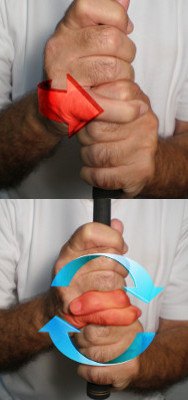
I have tinkered with my grip a hundred times in my life, and to be honest I have not found one that I prefer over the other. I am currently using the interlock grip, but throughout my entire college career I used the overlap. When looking at professional golfers, they tend to do the same. The majority of them use interlock a lot of the time, while others tend to stick with the overlap grip. There is no necessary right answer when looking at which grip style to use, but each of them do come with their own benefits. During this section, I will cover the pros and cons of each grip style. I know there are dozens of sites and articles out there that claim that one grip style is better than the other, but to be honest, you can benefit from either setup. You just need to find which one you are the most comfortable with.
If you are looking to play a draw, or if you are fighting off a fade, then the overlap grip is where you should start. This grip quite simple, and consists of placing the pinkie finger on your non glove hand over the top of your pointer finger on your glove hand. The easiest way to ensure you have this grip done correctly, is to simply take the standard ten finger grip. From here, lift your pinkie off of the club (non- glove hand) and place it over the top of your glove hand (between the pointer finger and middle finger). At first, you will probably feel uneasy with this switch, but as you continue to hit more shots, the new grip will feel quite natural. When you use this type of grip style, it allows for your hands to release easier through impact, resulting in the drawing motion of the golf ball. If you are fighting off a fade, then this is the route you would want to take. By allowing your hands to release through impact, you are ensuring that the hands are not left behind your swing, which is what can cause the fade to occur. Although this grip is becoming more and more popular throughout the golf world, beware before moving to this style. If you have smaller hands, then you should probably stick with the interlock grip. The overlap style is designed for golfers with bigger hands, because it allows for them to work in their natural free flowing motion.
If you are the type of golfer that wants to stick to the “old school” methods, then the interlock is for you. The interlock grip is the most classic grip in golf, and widely used across the entire golf industry. When you use the interlock grip, it allows for you to grip the club tighter, and it also limits the wrist movement through the swing. If you are fighting a hook, then it is time to turn to the interlock, which is the same grip I use. I fought a hook for years, and I tend to allow my wrists too much freedom during the swing, so I was left with no choice. By allowing my wrists to have too much freedom, it resulted in the frequent snap hook, and it was quite frustrating. I changed to the interlock grip and have not thought twice about it since.
If you are interested in changing your grip style, it can be quite simple, but you need to be ready to invest the time and practice to truly become comfortable with your decision. My suggestion to you, is to set aside one week of practice for each grip style. During week one, only use the interlock grip. You will need to hit two bags of balls per day, but do not hit the course until the final day of the week. I want you to go 100% with the interlock grip before taking it to the course. On the final day of your weekly practice, take to the course and put it to the real test. Track your results, and really pay attention to where the ball is moving during flight. After week one, then do the exact same method with the overlap grip. Invest fully into the week of practice, and play on the final day. Track the results and compare them to week one. If you are seeing better ball striking, and ultimately better scoring with one grip style, then there is your answer. Although the entire process does take two weeks to receive your final results, it is well worth the wait. When you complete the two week session, you will be able to confidently choose a grip style and apply it to your game for the years to come.





